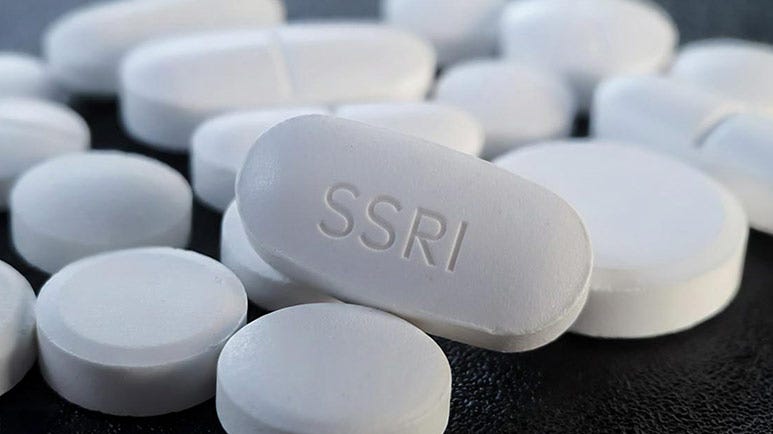Antidepressants (SSRI) Trigger Hyponatremia, Which Causes Severe Anxiety
Description
STORY AT-A-GLANCE
Antidepressants like SSRIs are strongly linked to hyponatremia, a dangerous drop in blood sodium that disrupts nerve and muscle function
The risk is highest in the first two weeks of treatment, when sodium levels plummet to life-threatening lows that trigger confusion, seizures, or fainting
Older adults, especially women over 80, are among the most vulnerable, with nearly 1 in 15 experiencing profound sodium loss after starting these drugs
Symptoms of drug-induced low sodium often mimic worsening anxiety or depression, leading to misdiagnosis and unnecessary increases in medication
Natural strategies like optimizing nutrition, restoring key vitamins and minerals, daily movement, sunlight exposure, and restful sleep offer safer ways to support mood and energy without creating sodium imbalances

Hyponatremia, or low sodium in the blood, is one of the most common electrolyte disorders seen in clinical settings, and its effects are anything but minor. Sodium keeps your nerves firing and your muscles working. When levels dip, even slightly, you feel drained, confused, or shaky. Push it further and symptoms like nausea, seizures, or fainting start to appear. In severe cases, sodium imbalance drives long hospital stays, lasting cognitive decline, and death.
Antidepressants such as selective serotonin reuptake inhibitors (SSRIs) are routinely prescribed for mood disorders, but what often gets overlooked is how they disrupt sodium balance in your body. This translates into real-world risks like falls, broken bones, and worsening mental health. Older adults, especially women, are hit the hardest, with even short-term use setting off dramatic shifts in sodium control.
The severity of harm varies depending on the drug, the dose, and how long it’s used, yet the outcome is always unpredictable — and sometimes catastrophic. Research makes it clear that these medications disrupt sodium balance in dangerous ways, and a major study to track this problem shows exactly how quickly and severely those drops in sodium occur.
Large Study Links Antidepressant Use to Severe Sodium Imbalances
A study published in the European Journal of Endocrinology investigated the connection between antidepressant use and a severe drop in blood sodium levels.1 Researchers examined data from 234,217 adults who had just started taking SSRIs or venlafaxine, brand name Effexor, to see how often sodium levels fell dangerously low.
Thousands developed dangerously low sodium — Among the participants, 3,999 went on to develop hyponatremia, defined in this study as blood sodium levels dropping below 125 mmol/L. For perspective, normal sodium sits between 135 and 145 mmol/L, so a fall to 125 is not just a small shift — it represents a level at which seizures, confusion, and hospitalization are likely. That’s why this condition is classified as “profound.”
Risk spikes quickly after starting medication — The data showed that the highest danger occurred in the first 14 days of treatment. In fact, people who had just begun antidepressants were more than 10 times more likely to develop profound hyponatremia compared to baseline.
Older adults and women were hit hardest — Elderly women stood out as the most vulnerable group, with nearly 1 in 15 women over 80 years old developing profound hyponatremia after starting treatment. This shows how important age and sex are when predicting side effects — factors that often get overlooked in quick prescribing decisions.
The problem is too much water retention — SSRIs and venlafaxine disrupt sodium levels through a condition called syndrome of inappropriate antidiuresis (SIADH). In plain terms, these drugs cause your body to release excess antidiuretic hormone, which signals your kidneys to hold onto water.
<label class="hide-text" contenteditable="false">Text within this block will maintain its original spacing when published</label>When your body retains too much water, the sodium in your blood becomes diluted — much like watering down soup — causing the sodium concentration to fall below the level your nerves and muscles need to function properly. The study tracked hospital admissions related to this known mechanism.
Antidepressant-Induced Low Sodium Triggers Anxiety
Bioenergetic researcher Georgi Dinkov points out a troubling reality: antidepressants that are supposed to calm anxiety actually cause it by lowering sodium levels in your blood.2 This condition produces the same agitation, panic, and fear that define anxiety disorders — essentially fueling the very illness these drugs are prescribed to treat.
A cycle that feeds itself — When sodium levels crash, patients often feel more restless, fearful, or paranoid. Instead of realizing this is a drug reaction, doctors frequently mislabel it as “worsening anxiety,” leading to higher doses or additional prescriptions. In this way, the treatment creates the very problem it claims to fix.
A danger long known, but ignored — According to Dinkov, the risks of SSRI-induced hyponatremia have been documented for decades. Yet, warnings remain hidden in fine print, dismissed as rare side effects rather than recognized as central dangers. This silence, he argues, amounts to deliberate negligence: the system profits when patients stay stuck in a loop of drugs and worsening symptoms.
Sodium is your brain’s power source — Think of sodium as the electrical charge that keeps your brain’s circuits running smoothly. When that charge falls, the system falters — like a phone trying to operate at 5% battery. The result? Mood swings, irrational fears, and panic attacks that are indistinguishable from a severe anxiety disorder.
Why recognizing the pattern matters — If your anxiety spikes shortly after starting one of these drugs, don’t assume it’s “your condition getting worse.” It’s likely your brain running out of its electrical fuel. Knowing this gives you the power to ask the right questions, demand sodium checks, and avoid being trapped in the cycle of drugs for symptoms the drugs themselves created.






